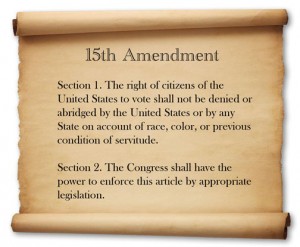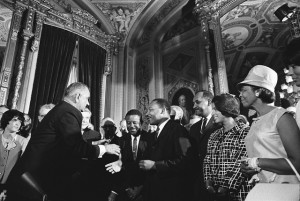 In 1965 Congress enacted and Lyndon Johnson signed the Voting Rights Act (VRA). The VRA was intended to deal specifically with roadblocks in place in certain states to voter registration by Black Americans. Certain provisions of the Act were originally set to expire in five years, but were renewed in 1970, 1975, 1982, and most recently in 2006 for another 25 years. The Supreme Court has been asked to find Congress’ actions in 2006 unconstitutional.
In 1965 Congress enacted and Lyndon Johnson signed the Voting Rights Act (VRA). The VRA was intended to deal specifically with roadblocks in place in certain states to voter registration by Black Americans. Certain provisions of the Act were originally set to expire in five years, but were renewed in 1970, 1975, 1982, and most recently in 2006 for another 25 years. The Supreme Court has been asked to find Congress’ actions in 2006 unconstitutional.
Question Before the Court is About the Constitution, Not About the Policy
“Whether Congress’ decision in 2006 to reauthorize Section 5 of the Voting Rights Act under the pre-existing coverage formula of Section 4(b) of the Voting Rights Act exceeded its authority under the Fifteenth Amendment …”
The case has provoked discussion about the state of continuing voter discrimination in the United States generally and in some areas specifically. Some have called the Court’s consideration of VRA’s constitutionality a “dark day”. These and other discussions about race, voter suppression and policy issues miss the point. The point is: Did Congress follow the Constitution in 2006?
The Fifteenth Amendment was Congressional Authority for the Voting Rights Act
 The opening phrase of the Voting Rights Act points to the Constitution’s 15th Amendment as congressional authority:[1]
The opening phrase of the Voting Rights Act points to the Constitution’s 15th Amendment as congressional authority:[1]
“AN ACT To enforce the fifteenth amendment to the Constitution of the United States,and for other purposes.”
The Constitution’s Fifteenth Amendment was ratified in 1870, following the Civil War. The Amendment’s goal was to guarantee voting rights for former slaves. It is short and to the point.
AMENDMENT XV
SECTION. 1. The right of citizens of the United States to vote shall not be denied or abridged by the United States or by any State on account of race, color, or previous condition of servitude.
SECTION. 2. The Congress shall have power to enforce this article by appropriate legislation.
(Emphasis added)
As one reads further keep in mind the term appropriate.
The 1960’s Problem and the Voting Rights Act Remedy
In the 1960’s, nearly 100 years after the Fifteenth Amendment, disenfranchisement of black voters remained widespread. Many states had laws in place to interfere with voter registration and voting by Black Americans.[2] VRA was to address that problem. VRA’s Section 2 prohibited such laws nationally. Parties anywhere in the country may seek remedies in court for abridgement of their voting rights on account of race or color based upon Section 2.
While there were problems for black voters nationally, in some places the problem was greater than in others. The problems were statistically demonstrated by extremely low black voter registration and low election participation among those eligible to vote. Special measures were deemed needed to address these specific places. The VRA’s Section 4 contains a formula designating the problem areas:
“… any State or in any political subdivision of a state which (1) the Attorney General determines maintained on November 1, 1964, any test or device, and with respect to which (2) the Director of the Census determines that less than 50 percentum of the persons of voting age residing therein were registered on November 1, 1964, or that less than 50 percentum of such persons voted in the presidential election of November 1964.”[3]
Problem States Required to Get §5 “Preclearance” When Passing New Voting Laws
 Nine states and part of seven others were designated as special voting problem areas based upon voter registration and voting percentages as of November, 1964.[4] These states became subject to the provisions of Section 5.
Nine states and part of seven others were designated as special voting problem areas based upon voter registration and voting percentages as of November, 1964.[4] These states became subject to the provisions of Section 5.
VRA’s Section 5 requires that any area designated in Section 4 wanting to change its voting laws[5] to either get permission from the US District Court in the District of Colombia[6] or from the US Attorney General. The commonly used process is to submit changes in voting procedures to the Attorney General 60 days before the changes are to be effective and is known as preclearance.
The 1965 idea was that certain areas had long histories of effectively interfering with the rights of black voters; any voting procedure changes in those areas needed to be reviewed by a federal official before going into effect. This has the effect of putting states, as Justice Kennedy described the situation, “under the trusteeship of the United States government”.[7]
Wrong Questions: Is There Continuing Voter Discrimination? Is the Act Working?
Much of the Supreme Court oral argument in the Supreme Court was a give and take on if there was a continuing need for VRA Section 5 monitoring of jurisdictions and abridgement of minority voting. Justice Sotomayor asked questions about the numbers of lawsuits filed. Chief Justice Roberts pointed out that of 3,700 requests in 2005 to alter a voting law by covered states the Justice Department rejected only one change.
Much of the Supreme Court discussion centered on whether the VRA had worked, if there was still a need and other policy questions. Most commentators have focused on the policy questions. Are there or are there not continuing official efforts to disenfranchise minorities? These are all value questions. Important questions to be sure, but questions that blur the constitutional issue.
The Right Question: Was Congress’ Action in 2006 Appropriate?
The 15th Amendment gives Congress power to enact “appropriate” legislation. In 2006, Congress imposed burdens on states based on formulas set down in 1965 and 1972 and the circumstances that existed then.
Attorney Bert W. Rein, representing Shelby County, came closest to getting to the real point:
“’Current needs have to generate the current burden. ‘So what happened in 1965 in Alabama, that Alabama itself has said was a disgrace, doesn’t justify a current burden.”
In 2006, Congress was simply too lazy to revisit the status of discrimination and change the formula or recognize changed circumstances.[8] As Judge Scalia so saliently pointed out, no Senator would dare vote against something called the Voting Rights Act.
The 2006 renewal of Section 5 of the Voting Rights Act simply was not “appropriate”. The Court should find it unconstitutional, and the Congress should actually do its job.
**Update: On June 25, 2013, the Supreme Court Section 5 unconstitutional in the case. Here is the opinion in Shelby County v. Holder.
[1] In keeping with the constitutional theory of limited government, Congress should denote the section of the Constitution it relied upon in passing a law. This would be good legislative practice, but is generally uncommon. Of disturbing note in the VRA preamble is the phrase “other purposes”. There certainly has been no constitutional grant of power to Congress for “other purposes”.
[2] There were many legal barriers in place such as literacy tests. In some places there were taxes placed on voting, and these taxes had been upheld by the US Supreme Court. To outlaw poll taxes nationally required ratification of the 24th Amendment in 1964.
[3] The 1975 renewal changed the relevant date for some jurisdictions to Nov. 1, 1972.
[4] Alabama, Alaska, Arizona, Georgia, Louisiana, Mississippi, South Carolina, Texas, and Virginia are fully covered by the Act. Counties or Townships in California, Florida, New York, North Carolina, South Dakota, Michigan and New Hampshire are covered.
[5] Section 5 preclearance is triggered if a covered State or subdivision “shall enact or seek to administer any voting qualification or prerequisite to voting, or standard, practice, or procedure with respect to voting different from that in force or effect on November 1, 1964.”
[6] The request to the District Court is for a Declaratory Judgment that indicates changes in voting procedures will not abridge voting rights on the basis of race.
[7]The State of Alaska has a suit pending in federal court also asking that VRA Section 5 be found unconstitutional. Alaska’s complaint gives a great description of the onerous nature of Section 5 preclearance procedures. That trusteeship has not always been benign. A Cato Institute brief filed in the Shelby matter tells of a Republican Justice Dept. that used the preclearance process to force Georgia to redraw its congressional districts to add an additional majority black district. The result was that the balance of the Georgia districts were essentially protected for the election of Caucasian candidates.
[8] Changed either for better or worse, perhaps worse in some places. The original act was designed to deal with disparities in black voter registration vs. white voter registration. According to Chief Justice Roberts, by that measurement, Massachusetts is the worst state in the union, and Mississippi, covered under the 1965 formula, is the best.








[…] department of the government to not enforce a law. A Supreme Court argument takes place about the constitutionality of legislation and no one discusses the […]